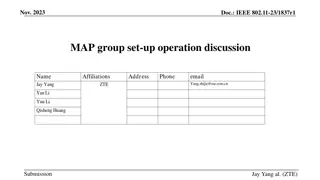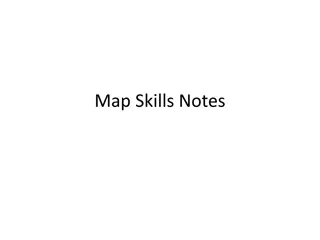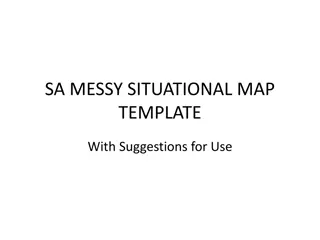Introduction to Map Reduce in Computer Science
Explore the concepts of Map Reduce in the world of Computer Science, covering topics such as word count, aggregation functions, and applications in solving real-world problems like finding the nearest Starbucks to a given location. Dive into the fundamentals of mapping nodes, splitting files, and independently mapping chunks in a distributed computing environment.
Download Presentation

Please find below an Image/Link to download the presentation.
The content on the website is provided AS IS for your information and personal use only. It may not be sold, licensed, or shared on other websites without obtaining consent from the author. Download presentation by click this link. If you encounter any issues during the download, it is possible that the publisher has removed the file from their server.
E N D
Presentation Transcript
Concurrency in Go CS 240 Fall 2018 Rec. 2
Housekeeping Should have a working doMap() in Assignment 1
We Should Probably Teach you Map Reduce The Hello World of Map Reduce: Word Count If we have time: Let s Make, a very basic, Google Maps from Raw Data (A Solution to the Final Project for CS 245 Databases) You re welcome
Abstract Map Reduce map(key, value) -> list(<k , v >) Apply function to (key, value) pair Outputs set of intermediate pairs reduce(key, list<value>) -> <k , v > Applies aggregation function to values Outputs result
A Motivating Problem for Map Reduce Find me the closest Starbucks to KAUST. Actually, I ll give you a place and something to look for, and you find me the closest one. Here s a 1 TB text file good luck GPS Coordinates [22.3, [22.2, [35.7, ... Site Name Tim Hortons KAUST Library Starbucks ... 39.1] 39.1] 139.7] In KAUST In Tokyo, Japan It s ok, I didn t want to enjoy my weekend anyway
A Motivating Problem for Map Reduce GPS Coordinates [22.3, [22.2, [35.7, ... Site Name Tim Hortons KAUST Library Starbucks ... 39.1] 39.1] 139.7] 0 1 2 3 4 0 (0,0) (0,1) (0,2) (0,3) (0,4) 1 (1,0) (1,1) (1,2) (1,3) (1,4) Reduce to single files Map to grids 2 (2,0) (2,1) (2,2) (2,3) (2,4) (3,0) (3,1) (3,2) (3,3) (3,4) 3
Split the File and Map Each Chunk Independently (1/2) Mapping Nodes Mapper GPS Coordinates Site Name [22.3, 39.1] [22.2, 39.1] [35.7, 139.7] Starbucks ... [42.0, 69.0] [22.2, 39.2] ... ... ... ... Tim Hortons KAUST Library ... Chanak Train Stop Burger King ... ... ... ... Mapper
Split the File and Map Each Chunk Independently (2/2) KEY <grid>: VALUE <locations and name> ... Mapping Nodes Notice the duplicate grids (KEYS) (1,2): [22.3, 39.1] Tim Hortons (1,2): [22.2, 39.1] KAUST Library (1,2): ... (2,4): [35.7, 139.7] Starbucks (2,4): ... Mapper GPS Coordinates Site Name [22.3, 39.1] [22.2, 39.1] [35.7, 139.7] Starbucks ... [42.0, 69.0] [22.2, 39.2] ... ... ... ... Tim Hortons KAUST Library ... Chanak Train Burger King ... ... ... ... (1,3): [42.0, 69.0] Chanak Train (1,3): ... (1,2): [22.2, 39.2] Burger King (1,2): ... Mapper
Collect the Mapper Results and Reduce to Single Files (1/2) Reducing Nodes (1,2): [22.3, 39.1] Tim Hortons (1,2): [22.2, 39.1] KAUST Library (1,2): ... (2,4): [35.7, 139.7] Starbucks (2,4): ... Reducer (1,2) (1,3): [42.0, 69.0] Chanak Train (1,3): ... (1,2): [22.2, 39.2] Burger King (1,2): ... Reducer (1,3), (2,4)
Collect the Mapper Results and Reduce to Single Files (2/2) KEY <grid>: [ VELUES <locations and names>, ...] Reducing Nodes (1,2): [ [22.3, 39.1] Tim Hortons, [22.2, 39.1] KAUST Library, [22.2, 39.2] Burger King ...] ] (1,2): [22.3, 39.1] Tim Hortons (1,2): [22.2, 39.1] KAUST Library (1,2): ... (2,4): [35.7, 139.7] Starbucks (2,4): ... Reducer (1,2) (2,4): [ [35.7, 139.7] Starbucks, ...] (1,3): [42.0, 69.0] Chanak Train (1,3): ... (1,2): [22.2, 39.2] Burger King (1,2): ... Reducer (1,3), (2,4) (1,3): [ [42.0, 69.0] Chanak Train Stop, ...],
How Hadoop Does it (1/2) Mapping Nodes Mapper Mapper
How Hadoop Does it (2/2) Mapping Nodes Reducing Nodes Mapper Reducer Mapper Reducer
What is Concurrency? It s like parallel that s not in parallel
What is Parallelism? Time Sequential f(X) = A f(X) f(Y) f(Y) = B Parallel f(X) f(X) = A f(Y) f(Y) = B
Parallelism in Go Demo: parallel.go
What is Concurrency? Time Sequential f(X) = A f(X) f(Y) f(Y) = B Concurrent f(X) = A f(X) f(Y) f(Y) = B
Concurrency Could be Parallel but not Always Time Concurrent but not Parallel f(X) = A f(X) f(Y) f(Y) = B Concurrent and Parallel f(X) = A f(X) f(Y) f(Y) = B f(Z) = A f(Z) f(W) f(W) = B
Parallel is Always Concurrent Time Parallel but not Concurrent? f(X) f(X) = A f(Y) f(Y) = B Nope still concurrent Parallel Concurrent Concurrent Parallel
Why Care about Concurrency If something concurrent but not parallel takes as much time as something sequential, why make it concurrent? Time f(X) = A Sequential f(X) f(Y) f(Y) = B Concurrent f(X) = A f(X) f(Y) f(Y) = B
Concurrency is a Design Pattern Concurrency is about dealing with lots of things at once. Parallelism is about doing lots of things at once. - Rob Pike Concurrency is not Parallelism by Rob Pike : https://talks.golang.org/2012/waza.slide#1
Distributed Systems are Unpredictable Servers need to react to: Others servers Crashes Users
The Design Problem Concurrency Solves Demo: concurrent.go
Making Bank Deposits Concurrent (1/5) Add($10 ) Server Database Add($10 ) 0 Time
Making Bank Deposits Concurrent (2/5) Add($10 ) Server Database Add($10 ) read Read x = 0 $0 0 Time
Making Bank Deposits Concurrent (3/5) Add($10 ) Server Database Add($10 ) read Read x = 0 x += 10 Write x $0 $10 10 Time
Making Bank Deposits Concurrent (4/5) Add($10 ) Server Database Add($10 ) read Read x = 0 x += 10 Write x $0 $10 10 read Read x = 10 $10 Time
Making Bank Deposits Concurrent (5/5) Add($10 ) Server Database Add($10 ) read Read x = 0 x += 10 Write x $0 $10 20 read Read x = 10 x += 10 Write x $10 $20 Time
Concurrent Bank Deposits! Yay? (1/5) Add($10 ) Server Database Add($10 ) 0 Time
Concurrent Bank Deposits! Yay? (2/5) Add($10 ) Server Database Add($10 ) read Read x = 0 $0 0 Time
Concurrent Bank Deposits! Yay? (3/5) Add($10 ) Server Database Add($10 ) read Read x = 0 Read x = 0 $0 read $0 0 Time
Concurrent Bank Deposits! Yay? (4/5) Add($10 ) Server Database Add($10 ) read Read x = 0 Read x = 0 x += 10 Write x $0 read $0 10 $10 Time
Concurrent Bank Deposits! Yay? (5/5) Add($10 ) Server Database Add($10 ) read Read x = 0 Read x = 0 x += 10 Write x x += 10 Write x $0 read $0 10 $10 $10 Time
Concurrency Needs to be Synchronized Locks limit access using shared memory Channels pass information using a queue
Channels, Locks and More Demo: sync.go
Visualize Everything Weve Learned And also see many different methods of achieving synchronization: http://divan.github.io/posts/go_concurrency_visualize/























